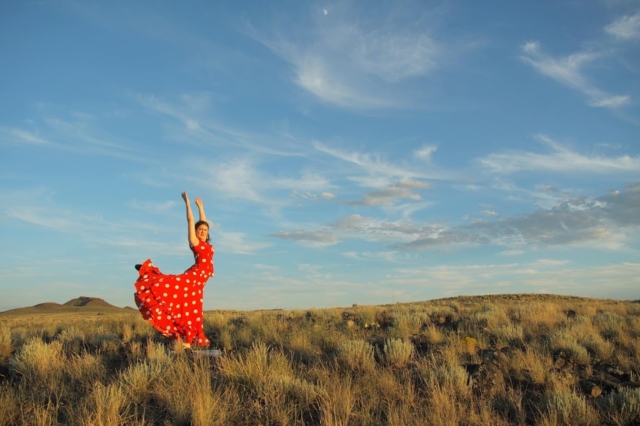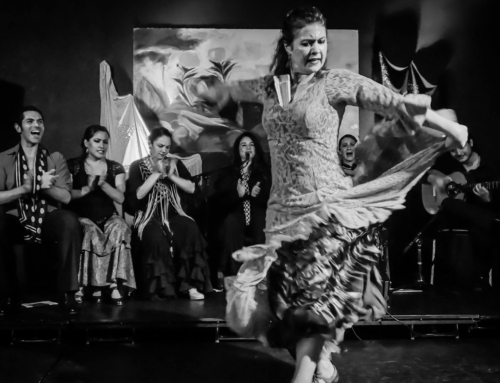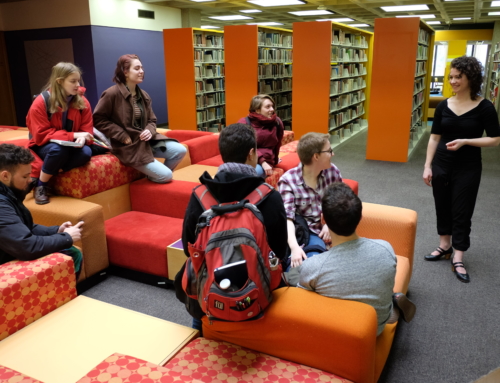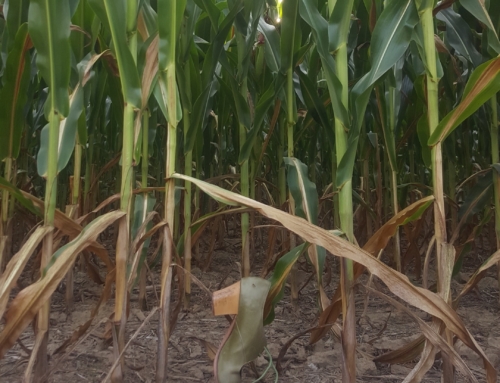A couple of flamenco dance friends and I were talking about the lack of nice studio space in Sevilla on a recent afternoon. Most of the studios available to rent for rehearsals are small, dark, full of dust, with uneven floors, and not very high tech sound systems. And performance spaces tend to be small tablaos or music venues–intimate spaces that are limiting in the size of the stage. So we started thinking–how would flamenco evolve if it were performed and rehearsed in large spaces?
There’s enough information on space and dance for me to write a complete thesis on it–and hey, maybe I will next year for my MFA–for now, just some thoughts on the topic:
You definitely do not see ballet or contemporary dance companies performing or rehearsing in rooms the size of a NYC apartment. In New York, Ailey’s studios have stunning large windows and high ceilings, Mark Morris’ studios have huge ceilings–I can only imagine what NYC Ballet and ABT’s rehearsal spaces must be like…And yet the flamencos are in tiny spaces with small windows.
I can say from personal experience, the space you are dancing in changes the way you move. Dancing outside, for example, feels totally different than dancing in an enclosed room; outside, there’s a freedom that a walled space lacks. Last summer I created a piece that was inspired by the feeling of running through grass with bare feet. I wanted to re-create that feeling in dance, even though I performed the final piece in a studio. I ended up collecting piles of grass to help create the same sensations indoors; I researched by dancing outside, becoming conscious of how moving on a grassy hillside felt, what it inspired in my body. When I get to an open space, I’m often overcome by an intense desire to just run–as fast and as far as I can. On tour last year, at White Sands, after a long day in cramped spaces (planes and cars and airports), we arrive and I immediately took off sprinting over the dunes. You feel the air rushing around you; you experience space differently outside when there are no boundaries. Experiencing the space around us is essential to dance.
 |
| Photo: Pat Barrett. Location: West Mesa in Albuquerque, NM. |
When I think about space and dance, I think of Liz Lerman and Pina Bausch creating works outside in large, unconventional venues. Lerman writes about her challenges in mounting works in alternative spaces in her book, Hiking the Horizontal. She writes;
“I began choreographing for spaces other than the theater for several reasons. I wanted to celebrate a community of dancers and needed a site appropriate for such an event…I hoped that audiences would delight in new opportunities to see bodies in relationship to familiar and unfamiliar landscapes…I have made many more dances in many other places, motivated by curiosity about performance, site, audience, vocabulary….A fresh choreographic challenge always presents itself because of scale, sight lines, intimacy, and perspective…Site-specific work offers a choreographer the chance to affect audiences’ ideas about art and architecture through the impact of dancing in a space. I think we are at our most successful when we make it possible for people to undergo a fresh understanding of their surroundings, of an idea, or of their own relationship to artistic experience. Often all three happen at once…”
And for anyone unfamiliar with Bausch, here is a short clip of some of her works:
In flamenco classes, we often stay facing the mirror; there are few exercises that travel, that use the space. In a flamenco class, we could never leave the space created by the diameter of or arms. I feel like we are missing out on so much in flamenco!…And this is why there are dancers whose capacities in a tablao appear outstanding, but on a large stage they cannot seem to transmit anything; they do not know how to transmit in such a large space. There are dancers that face the opposite challenge, and a handful of dancers that do both well. In a small space, we can get away with dancing smaller; our facial expression reads as much as our bodies. In a theater, not so much.
Here’s a particular challenge to flamenco; acoustics and the musicians. I will never understand why in a small venue, flamencos feel the need nowadays to use amplification. One of the greatest aspects of the peñas (flamenco clubs) in Andalucía is the lack of amplification. Of course, everyone attending shows are there solely to hear and see flamenco, not to talk, eat, or ignore the performers (a common occurrence in many Spanish restaurants in the U.S. that hire flamencos for entertainment).
I came across a study a PhD thesis from the University of Sevilla entitled, “Espacios sonoros del flamenco” [Flamenco sound spaces] regarding flamenco and architecture. Guillermo Teba García brings up interesting points about the environments in which flamenco was created, and where it is performed now, and that theaters do not provide, or cannot efficiently re-create the ideal spaces to listen to flamenco… Garcia writes;
“Y siendo, cómo lo es, el flamenco una música tan universal como andaluza, aún desconocemos las condiciones acústicas requeridas para su interpretación y su recepción como espectáculo en los teatros y auditorios…La aproximación histórica de los espacios sonoros del flamenco ha demostrado la unión indisoluble que existe entre el flamenco y el espacio seleccionado para su interpretación a lo largo de su desarrollo histórico….Hemos constatado cómo el corral de vecinos de Triana es acústicamente eficaz para la interpretación del flamenco de uso. El volumen, la geometría, la absorción de las superficies y la manifestación artística que se interpreta en su interior, es decir, el flamenco, conforman una situación realmente optima y atractiva para escuchar arte jondo. Su condición de espacio semi-abierto favorece la transmisión del cante, ya que evita reverberaciones excesivas para su comprensión…”
[And as it is, flamenco a music as universal as it is Andaluz, still we don’t know the required acoustic conditions for its performance and reception in theaters and auditoriums. The historical approximation of flamenco sound spaces has shown the indissoluble connection that exists between flamenco and the space selected for its performance throughout its history…We have confirmed how the neighborhood yard in Triana (a neighborhood in Sevilla) is acoustically effective for flamenco performance use. The volume, geometry, absorption by the surfaces and the artistic manifestation that is performed in its interior, which is to say flamenco, shapes an optimal and attractive situation to listen to arte jondo (deep song in flamenco). The condition of its partially open space favors the transmission and understanding of the singing, as it avoids excessive reverberations…]
(Arrojados al Mundo, Arrojados del Mundo, Master Universitario en Ciudad y Arquitectura, June 2011, Catálogo Exposición, https://books.google.es/books?id=2n31NlitAVoC&pg=PT136&lpg=PT136&dq=el+flamenco+y+espacio&source=bl&ots=BnvR3WTFLF&sig=-oJhkLxXz0ITli7agrFn24ZrVe8&hl=en&sa=X&ved=0ahUKEwi-1tjE9JrMAhVEVxoKHYnYBzQQ6AEIZjAJ#v=onepage&q=el%20flamenco%20y%20espacio&f=false)
In all honesty, flamenco dancers lack knowledge about space and spacing. When I started working with Flamenco Vivo, I had to remember basic blocking and spacing concepts; I had spatial awareness buried in my brain/body thanks to ballet training, but had been mostly working as a soloist in very small venues in NYC and hand to re-acquaint myself with spike marks and the likes on a large stage (another reason I am oh-so-thankful for my ballet training!). Flamenco dancers often have trouble shifting their weight quickly and traveling because that simply cannot occur in a small space.
Perhaps one of the most influential ways of thinking about moving through space are the Laban points in space and Laban’s “Space Harmony.” Laban created scales that are similar to musical scales, but instead covering axises of movement. As a dancer, knowing these scales helps to understand my relation to the space around me. Laban also created a way to notate dance, and any human movement, based on space and other aspects such as effort, mobility, expression. I’ve only had acute access to the methodology; for more info, see the wikipedia pages: https://en.wikipedia.org/wiki/Laban_Movement_Analysis#Labanotation, https://en.wikipedia.org/wiki/Space_Harmony, and visit the Institute of Movement Studies web at http://www.limsonline.org/
Here’s what we have to remind ourselves as dancers; we control our bodies, but we also control the “negative space” around us–it’s not just the shapes we sculpt with our body, but the way we sculpt and control the air we move through. We shape the space, and space functions as a choreographer’s canvas.
And in researching this topic, I came across the following doctoral thesis by Valerie A. Briginshaw, entitled, “Dance, space and subjectivity.” Here is a link to the complete thesis: https://core.ac.uk/download/files/356/12983819.pdf (University of Southampton, 2001).
“Space then, like subjectivity, is a construct, a human or social construct, and so it cannot be explored without reference to human subjects. Possibly the most immediate relationship of subjects to space is through their bodies since ‘it is by means of the body that space is perceived, lived – and produced’ (Lefebvre, 1974 transl. 1991:162). Constructions and conceptions o f space produced in this way are inextricably bound up with conceptions of time such that ‘it is not possible to disregard the fatal intersection of time with space’ (Foucault,1986:22). Space as a product has a history (Lefebvre, 1991) which is forever changing through time. This is important when the roles of space and body/space relations in constructions of subjectivity in dance are examined…”
Now another thought; will something be lost if flamenco leaves behind the small intimate spaces in which it formed? Can flamenco exist in both spaces, or will some flamenco branch off into another genre or sub-genre?







You have a lovely blog.